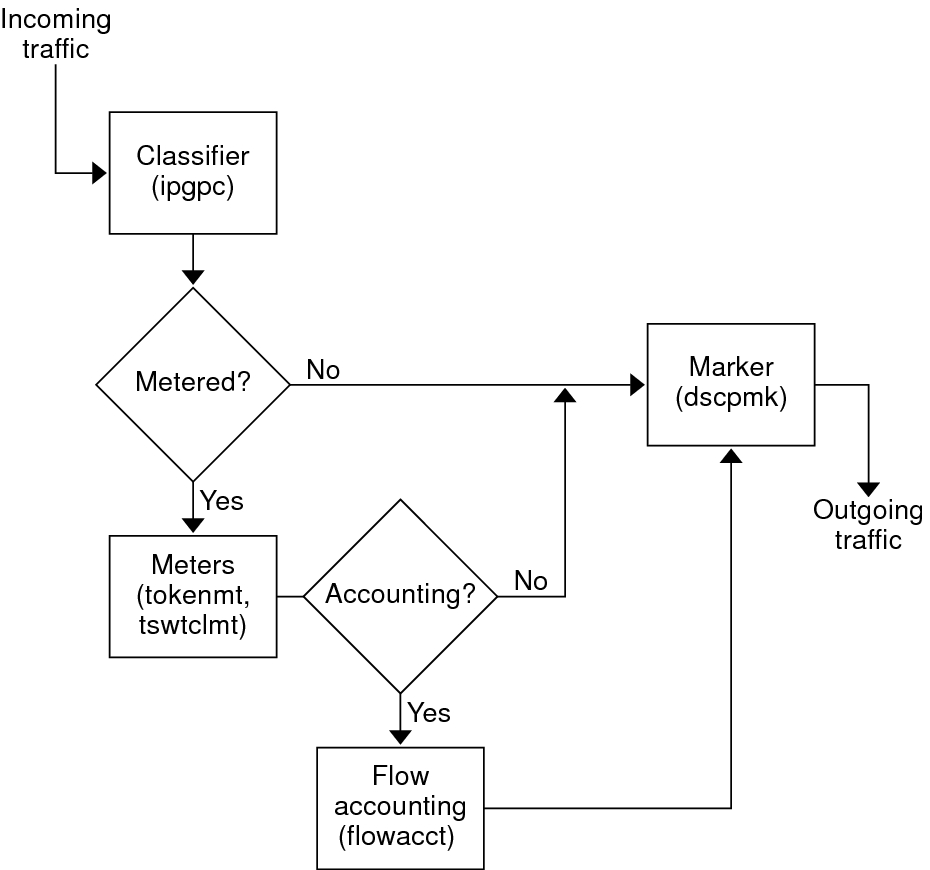Differentiated Services Model
Classifier
Meter
Marker
IPQoS includes the following modules, which are part of the Diffserv architecture that is defined in RFC 2475:
Flow-accounting module
802.1D datagram marker
IPQoS adds the following enhancements to the Diffserv model:
This section introduces the Diffserv modules as they are used by IPQoS. For detailed information about each module, refer to IPQoS Architecture and the Diffserv Model.
Classifier (ipgpc) Overview
Source address
Destination address
Source port
Destination port
In the Diffserv model, the classifier selects packets from a network traffic flow. A traffic flow consists of a group of packets with identical information in the following IP header fields:
In IPQoS, these fields are referred to as the 5-tuple.
The IPQoS classifier module, ipgpc, arranges traffic flows into classes that are based on characteristics you configure in the IPQoS configuration file.
For detailed information about ipgpc, refer to Classifier Module.
IPQoS Classes
Grouping traffic into classes is a major part of planning your QoS policy. When you create classes by using the ipqosconf utility, you are actually configuring the ipgpc classifier.
For information about how to define classes, see Defining the Classes for Your QoS Policy.
IPQoS Filters
Filters are sets of rules that contain parameters called selectors. Each filter must point to a class. IPQoS matches packets against the selectors of each filter to determine whether the packet belongs to the filter's class. You can filter on a packet by using a variety of selectors, for example, the IPQoS 5-tuple and other common parameters:
Source address and destination addresses
Source port and destination port
Protocol numbers
User IDs
Project IDs
Differentiated Services Codepoint (DSCP)
Interface index
For example, a simple filter might include the destination port with the value of 80. The ipgpc classifier then selects all packets that are bound for destination port 80 (HTTP) and handles the packets as directed in the QoS policy.
For information about creating filters, see How to Define Filters in the QoS Policy.
Meter (tokenmt and tswtclmt) Overview
In the Diffserv model, the meter tracks the transmission rate of traffic flows on a per-class basis. The meter evaluates how much the actual rate of the flow conforms to the configured rates to determine the appropriate outcome. Based on the traffic flow's outcome, the meter selects a subsequent action, such as sending the packet to another action or returning the packet to the network without further processing.
The IPQoS meters determine whether a network flow conforms to the transmission rate that is defined for its class in the QoS policy. IPQoS includes two metering modules:
Both metering modules recognize three outcomes: red, yellow, and green. You define the actions to be taken for each outcome in the parameters red_action_name, yellow_action_name, and green_action_name.
In addition, you can configure tokenmt to be color aware. A color-aware metering instance uses the packet's size, DSCP, traffic rate, and configured parameters to determine the outcome. The meter uses the DSCP to map the packet's outcome to green, yellow, or red.
For information about defining parameters for the IPQoS meters, refer to How to Plan Flow Control.
Marker (dscpmk and dlcosmk) Overview
In the Diffserv model, the marker marks a packet with a value that reflects a forwarding behavior. Marking is the process of placing a value in the packet's header to indicate how to forward the packet to the network.
dscpmk – Marks the DS field in an IP packet header with a numeric value that is called the Differentiated Services codepoint, or DSCP. A Diffserv-aware router can then use the DS codepoint to apply the appropriate forwarding behavior to the packet.
dlcosmk – Marks the virtual local area network (VLAN) tag of an Ethernet frame header with a numeric value that is called the user priority. The user priority indicates the class of service (CoS), which defines the appropriate forwarding behavior to be applied to the datagram.
dlcosmk is an IPQoS addition that is not part of the IETF Diffserv model.
IPQoS contains two marker modules:
For information about implementing a marker strategy for the QoS policy, see Planning Forwarding Behavior.
Flow Accounting (flowacct) Overview
IPQoS adds the flowacct accounting module to the Diffserv model. You can use flowacct to gather statistics on traffic flows, and bill customers in agreement with their SLAs. Flow accounting is also useful for capacity planning and system monitoring.
Source address
Source port
Destination address
Destination port
Protocol number
Number of packets
Number of bytes
The flowacct module works with the acctadm command to create an accounting log file. A basic log includes the IPQoS 5-tuple and two additional attributes:
You can also gather statistics on other attributes, as described in Recording Information About Traffic Flows, and in the flowacct(7ipp) and acctadm(1M) man pages.
For information about planning a flow-accounting strategy, see Planning for Flow Accounting.
How Traffic Flows Through the IPQoS Modules
The following figure shows a path that incoming traffic might take through some of the IPQoS modules.
Figure 1 Traffic Flow Through the IPQoS Implementation of the Diffserv Model

The classifier selects from the packet stream all packets that match the filtering criteria in the system's QoS policy.
The selected packets are then evaluated for the next action to be taken.
The classifier sends to the marker any traffic that does not require flow control.
Traffic to be flow-controlled is sent to the meter.
The meter enforces the configured rate. Then, the meter assigns a traffic conformance value to the flow-controlled packets.
The flow-controlled packets are then evaluated to determine if any packets require accounting.
The meter sends to the marker any traffic that does not require flow accounting.
The flow-accounting module gathers statistics on received packets. The module then sends the packets to the marker.
The marker assigns a DS codepoint to the packet header. This DSCP indicates the per-hop behavior that a Diffserv-aware system must apply to the packet.
This figure illustrates a common traffic flow sequence on an IPQoS-enabled machine: